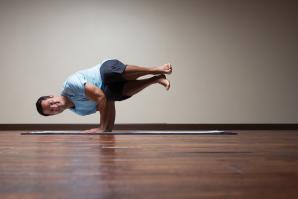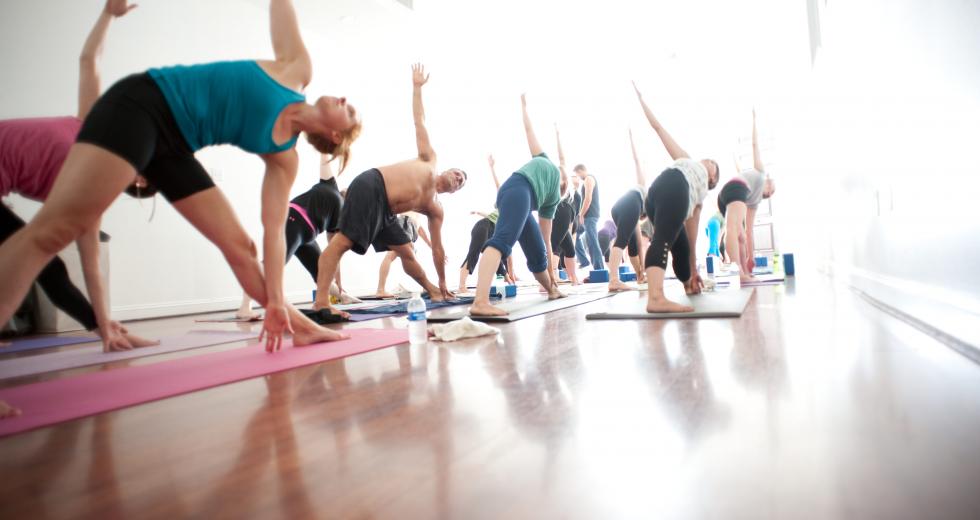In a Thursday morning’s darkness, the hardwood floor of Yoga Shala is covered wall to wall in rubber mats. Seated, students center their breath as instructor Tyler Langdale begins the Vinyasa class.
Langdale says his studio has seen more than 2,000 students since he opened Yoga Shala with lobbyist and fellow yogi Josh Pane in July 2010. Although born in a time of uncertainty for many businesses, Yoga Shala — like Sacramento’s yoga industry — shows no sign of slowing.
“Yoga is blowing up in Sacramento,” Langdale says.
The Sacramento Department of Revenue Services reports that 16 yoga studios hold active business operations tax accounts in the city, six of which opened in 2010. There are a number of others, including Asha Yoga, The Yoga Solution and The Sacramento Yoga Center, not on record with the city or the Secretary of State’s website. Though it seems to go against the grain of decreased spending on so-called luxuries generally experienced during economic slumps, Sacramentans seem to be doing more downward dog in light of — rather than in spite of — the downward economy.
Anne Marie Kramer, owner of the four-year-old Zuda Yoga, says, “We get lost. We get caught up in consumerism and materialism. That has never been the path to happiness, and yoga is a reminder of that.”
Local instructors and students say yoga’s 5,000-year-old holistic approach to wellness and spiritual philosophy keeps the practice in high demand in Sacramento.
“There is a consciousness about the way of living that is simple and peaceful here,” Langdale says.
Justin Knighten, who has practiced at several studios around town and has invested in high-priced monthly memberships, says he considers yoga as a “sort of preventative health care.” Studios stay afloat, he says, because they provide the supportive environments, eclectic communities and high-caliber instructors that compel city dwellers to continue paying for classes that can cost $20 per session.
Although the Sacramento demographic has proven its willingness to support local yoga businesses in a rough economy, keeping costs low remains a priority.
Yoga Shala, for example, entered the market with a recession-friendly launch.
“We started on a shoestring,” Langdale says of the studio, which opened turn-key: first at the YWCA of Contra Costa/Sacramento and then at a pre-existing yoga studio at 2030 H St. where he offers 25 weekly classes where students pay $10 to $15 per class.
Within weeks of Yoga Shala welcoming its first students, two other studios opened their doors, including One Flow Yoga Studio and Padme Yoga Center, says Padme owner Sophie Levy.
Levy estimates she invested more than $45,000 in startup and pays an estimated monthly overhead of $10,000, which is just a bit more than what Langdale pays. Those costs include rent and utilities, insurance, taxes and salaries plus, at some studios, health benefits.
“I’m not encouraging anybody to open up a yoga studio in this economic climate. … That struggle is really difficult,” Langdale says.
At launch, Levy hoped demand wouldn’t suffer because of increased supply.
“I got really worried,” she says, but Padme now offers 30 classes a week with prices comparable to Yoga Shala and is thriving despite a higher bottom line. “We are definitely covering our costs,” Levy says, adding that the studio gains students from its close proximity to the Sacramento Natural Foods Co-op.
“I thought August was going to be our lowest month,” she says, “but it was our best.”
The growth of the yoga market is visible across the United States. New York-based GfK Mediamark Research & Intelligence LLC reports that the number of people practicing yoga across the country increased more than 23 percent to 13.7 million between spring 2008 and spring 2010. In the country’s Pacific region, which includes California, Oregon and Washington, the number of yoga participants grew more than 20 percent to 2.74 million, leading the second-highest yoga-demanding region by more than 16 percent.
This boost in activity certainly helps Sacramento’s yoga industry cover its costs, and offering specials or promotions increases exposure and security, especially to younger studios. Plus, they ease strain on consumers with tighter purse strings.
“I give specials to give (students) opportunities because really that’s what businesses have to do these days,” says Langdale.
Sacramento resident Christina Jewett, for example, took advantage of Yoga Shala’s LivingSocial deal in which Langdale offered 10 classes for $30. “He made it very affordable,” says Jewett, who typically stays conservative with her yoga investment as she also incurs a monthly gym membership fee of $35.
“I’ve done some of the introductory offers around town, but I kind of hit a wall when I saw that $100-a-month price tag,” she says.
A monthly membership at Yoga Shala is $99 with a three-month automatic renewal; at Zuda yoga, it’s $150 without an automatic renewal or $119 with one; and Padme Yoga Center costs $99 monthly with an automatic renewal or $130 without. All of the studios also offer heavily discounted introductory rates and pay-as-you go punch cards.
Yoga memberships are often more expensive than gym memberships, but Levy says you get what you pay for: “I don’t think you can compare a gym to a yoga studio. It would be like comparing McDonald to Biba Restaurant. Why do places like Biba charge more? Quality, of course; service, atmosphere, etc. People have a misconception that a yoga studio can be compared to a gym; it is a very different experience.”
Sensitive to recent financial struggles and equipped with packed classes, some studios are going beyond promotions and offering free classes. Kramer at Zuda Yoga offers four free “karma” classes a week at her two locations (she is about to open a third), and Levy at Padme Yoga offers free classes to people who work a few hours at her studio through Padme’s Seva Program. The instructors’ philosophy of building a yoga community over building profit may fly in the face of a traditional business strategy, but it works to accomplish her inherent vision.
“I will work with (students who cannot pay),” Levy says. “For me, the most important thing is for them to come to a regular practice. It will change their lives, and if we change one life at a time we will change the entire community. That’s really the goal.”
Recommended For You

Hurts So Good
Yoga is good for you, but be careful boys
I’ve always snickered at yoga.It just seemed ridiculous. But men are flocking to yoga the way we once, in the ’80s, took to this thing called “jogging.” We’re learning that yoga bestows a slew of health benefits — physical, mental, even sexual. But new research also points to increased health risks for men, and this muddies the decision.

Flexible by Definition
Pilates maintains popularity and expands its reach
When Kelly Sassman started giving Pilates instruction at her Sacramento studio 12 years ago, people couldn’t even pronounce the name of the fitness program.



